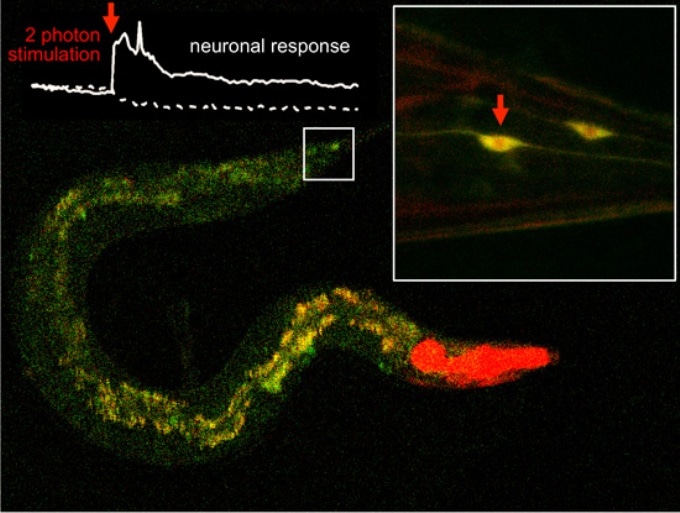Mar 4 2019
Deciding when, where, and how a drug is triggered, or having complete control of the activity of an individual molecule inside an organism are some of the goals anticipated to be reached with what is known as photoswitchable molecules—compounds that alter their properties in the presence of certain light waves.
 Control of the activity of individual worm neurons through two-photon stimulation. In the image, a neuron in the tail of the worm (enlarged square region) is stimulated with pulses of infrared light in the presence of the new molecule and an activation response occurs. (Image credit: Montserrat Porta, Aida Garrido)
Control of the activity of individual worm neurons through two-photon stimulation. In the image, a neuron in the tail of the worm (enlarged square region) is stimulated with pulses of infrared light in the presence of the new molecule and an activation response occurs. (Image credit: Montserrat Porta, Aida Garrido)
Now, thanks to the outcomes of a study, headed by the Institute for Bioengineering of Catalonia (IBEC) along with the Universitat Autònoma de Barcelona (UAB), the research community is one step closer to realizing this goal.
For the first time, researchers have managed to trigger molecules present deep within the neural tissue using pulsed infrared light lasers and with an efficiency of nearly 100%.
It’s a development that opens the door to a large number of applications. From drugs that only act at the point of our body that is illuminated and are therefore free from unwanted side-effects in other regions, to the spatial and temporal control of any protein whose function we want to study in the context of an organism.
Pau Gorostiza, Research Professor, ICREA.
Gorostiza is also the head of the Nanoprobes and Nanoswitches Group at IBEC.
The results of the study have been reported in the journal, Nature Communications.
High-precision photosensitive switches
The unique photoswitchable molecule used by the scientists is the latest variant of azobenzene—a chemical compound that assumes a flat shape in the dark but bends upon exposure to light. Photopharmacology is trying to exploit this unusual property to regulate the drugs’ activity: for instance, combining an inactive drug with azobenzene to administer into the body. Moreover, the design of the drug will allow it to work only when the azobenzene is bent. In this manner, in spite of being distributed across the body, the drug will take effect only at the points where the light stimulating azobenzene is irradiated, thereby preventing the side-effects related to the action of the drug in sites where there is azobenzene, as it is not required.
To date, continuous-wave lasers of blue or violet light (one-photon stimulation) were used by methods based on photoswitchable molecules to stimulate these compounds. This technique, however, does not enable the focalization of the stimulus.
“We wanted the molecule to be activated at a specific point, not along the whole beam of light that we irradiate. We saw that two-photon transitions using pulsed infrared light, allowed to achieve this, but the efficiency was very low, and the applications were limited. The molecules we have developed now achieve this effect with 100% efficiency. It is a very robust and precise technology to manipulate neuronal activity,” stated Jordi Hernando and Ramon Alibés, scientists from UAB’s Department of Chemistry who have directed part of this study along with Félix Busqué and Josep Mª Lluch.
Scientists have demonstrated the method’s effectiveness on mouse neurons as well as in an animal model—the Caenorhabditis elegans worm—for research on neuronal circuits.
“Despite the cells in a neuronal tissue being very close together, we have managed to select those in which we wanted to activate the photoswitchable molecule.”
Stimulation through two-photon absorption, projected by Maria Göppert-Mayer and demonstrated utilizing the pulsed lasers created by Gérard Mourou and Donna Strickland—Nobel Prize winners in Physics in 2018—has indicated a revolution for the manipulation and visualization of neuronal activity. The outcomes of this development provide immense possibilities, because they pave the way to new areas of research in the molecular field.
With the method described, researchers will have unparalleled spatiotemporal control over any kind of photoswitchable molecule they want to study.
The research was headed by IBEC, member of the Barcelona Institute of Science and Technology (BIST), along with the UAB’s Department of Chemistry, with the participation of Michael Krieg’s team from the Institute of Photonic Sciences (ICFO).